Buildings today are hollow and multilayered with numerous air gaps or void spaces. Chases, shafts, soffits and drops abound. Everything is connected to everything else, typically unintentionally. Buildings are complex three dimensional airflow networks [1]. This is not good. Buildings once were solid and compartmentalized. They were heavy and massive and expensive because they were heavy and massive. Heavy and massive also constrained us in other ways—we couldn’t go tall. To save money we made walls light; to go tall we made walls light. To make walls light, we made them hollow.
What is so bad about hollow? The voids allow air to flow through the fabric of modern buildings, resulting in airflow networks that can carry moisture that impacts a materials long-term performance (serviceability) and structural integrity (durability). They also affect building behavior in a fire (spread of smoke and other toxic gases, supply of oxygen), indoor air quality (distribution of pollutants and location of microbial reservoirs) and thermal energy use.
The airflow networks do not become networks until we get pressures to drive the flows. Hollow gives us paths but paths by themselves do not lead to flows. However, when we add air-based HVAC life gets interesting. We tend to accidentally couple mechanical systems to building enclosures resulting in pressures within the building “hollows.”
Within the building, walls are hollow and filled with air. The studs are steel and perforated. When covered by gypsum board they can be considered flat, rectangular ducts. When they are insulated with fiberglass batts, the “wall ducts” have a poor filter that does next to nothing to retard airflow. The “wall ducts” are also perforated by electrical outlet boxes and other services. These hollow exterior and interior perforated walls are connected to each other creating hollow cubes that have tops that are also hollow by virtue of dropped ceiling and bulk head construction.
Most dropped ceilings are typically return air plenums that now suck on the sides of the cube—the interior and exterior walls (Figure 1). When we add horizontal and vertical chase ways, soffits and shafts we have the typical modern office building, hotel or school—a classic indeterminate system that folks insist on trying to model. Even more useless are the attempts to understand microbial contamination in these buildings by doing air sampling for mold. A futile exercise if the airflow pathways and flows are not determined and quantified. Something that is typically impractical to do and may in fact be impossible in many buildings.

Figure 1: Dropped Ceiling Return Plenum—Negative pressure field in the dropped ceiling return plenum extends to exterior accidentally coupling the HVAC system to the building enclosure.
If I were in charge I would ban dropped ceiling return air plenums (Photograph 1). You just know that the interior gypsum board lining does not extend to the underside of the floor or roof system of the majority of buildings (Photograph 2). And even if it does it is rarely sealed. As a result exterior air is sucked through the air porous insulation right into the return plenum. It the outside air is humid, and if the space is air conditioned we loose control of the relative humidity in the dropped ceiling and the ceiling tile begin to smell like vomit (really—the butyric acid found in ceiling tile does smell like vomit as the relative humidity goes up) or the space smells like dirty socks (really—bacteria growing on coils from a moisture load the designer did not anticipate does smell like dirty socks). What are the odds? I can’t tell you the number of buildings we have had to go into and retrofit a closure at the plenum to exterior wall connection (Photograph 3). This is another example of problems that result from the widespread failure to provide a continuous air barrier system in a building.
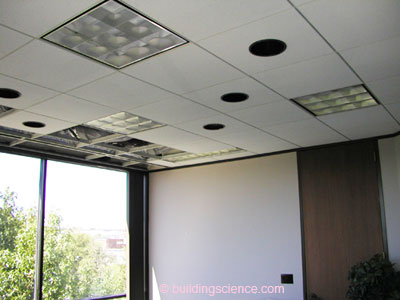
Photograph 1: The Ubiquitous Dropped Ceiling Return Plenum—Who knows what evil lurks hidden above the ceiling tile? The Building Scientist knows…

Photograph 2: Lack of Closure—The gypsum board does not extend to the underside of the floor assembly above. Note the discolored insulation due to the filtration effect of dust being retained as exterior air is pulled through insulation into the return plenum.
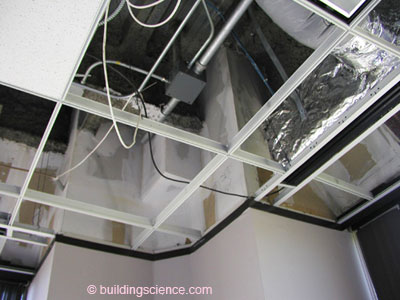
Photograph 3: Retrofit of Closure—Gypsum board extended to underside of floor assembly and sealed creating closure.
So what to do? Install a return duct on each air-handling unit in a dropped ceiling and pull air from the space below. Get rid of every 20th ceiling tile and install a grate to equalize the pressure between the occupied space and the dropped ceiling (Figure 2). The return system does not have to be extensive and fully ducted. Use transfer grilles and transoms to bleed the pressure from rooms with doors (Figure 3). And create a closure—seal the exterior wall to the floor above and the floor below creating a continuous air barrier. Note: mineral wool meets the fire requirements but does not stop airflow, so don’t shove mineral wool into a gap that leads between floors and think you have done a good deed—fire-rated foam, mastic or sealant needs to be used.
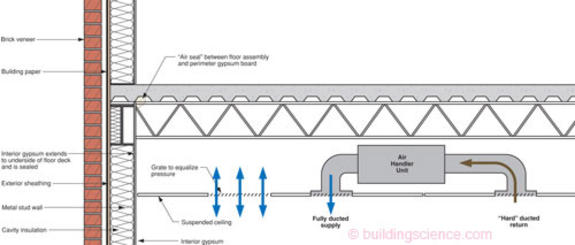
Figure 2: Uncoupling Dropped Ceilings from Building Enclosures—Create a closure by extending the interior gypsum board to the underside of the floor deck, add a return air duct to the air handling units and equalize the air pressure between the dropped ceiling and the occupied space by adding ceiling grates.
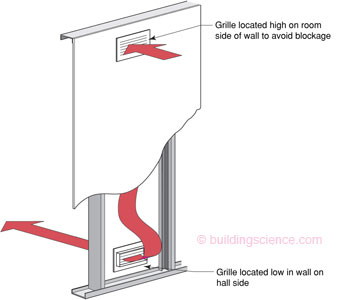
Figure 3: Transfer Grille—Transfer grille provides a path for return air into a common area that contains a ducted return.
What can be baffling at times is that the hollow “wall ducts” can operate under air pressure regimes (fields) that are largely independent of the air pressures on either side of them. Consider a hotel room with a bathroom exhaust duct located in a dropped ceiling above the bathroom. It is not practical to seal this duct airtight—although attempts are made. When this duct “leaks” it draws air from the dropped ceiling depressurizing it. This dropped ceiling is connected to the demising wall that separates units and this demising wall extends to the exterior (Photograph 4). This demising wall is now a “duct” that pulls air from the exterior and supplies it to the dropped ceiling (Figure 4). It the outside air is humid, and if the space is air conditioned, and if the walls are covered with vinyl wallpaper we get mold (Photograph 5). What are the odds?
Photograph 4: Hotel Room Flow Path Part I—Dropped ceiling connected to interior wall connected to demising wall connected to exterior.
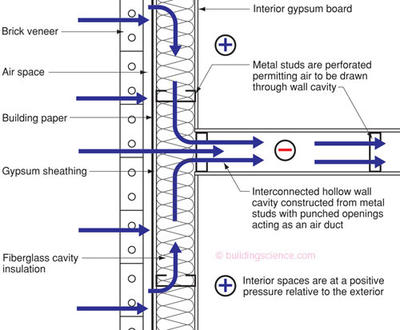
Figure 4: Wall Ducts—Interior wall with negative pressure field created by accidental coupling of HVAC system or exhaust fans to wall cavity creates a pathway for exterior air to enter building interstitial cavities.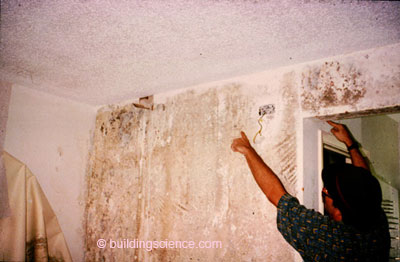
Photograph 5: Hotel Room Flow Path Part II—Mold on interior wall resulting from exterior humid air being pulled into demising wall as a result of negative pressure field created by leakage of exhaust fan in bathroom dropped ceiling.
So what to do in this case? Provide a continuous air barrier at the exterior wall. Add a grille in an interior wall that bounds the dropped ceiling near the ceiling where this interior wall connects to the demising wall to “bleed” the pressure so that a negative pressure field is not set up in the demising wall. Do not add a grille to “bleed” the pressure in the demising wall as this will cause the fire protection engineers head to explode – as well as violate the smoke and fire rating of the assembly. And oh yes, don’t install vinyl wall coverings.
We’re not done with hotels yet. Fan coils and air handlers suspended from ceilings in gypsum board enclosures give me heartburn. These units have a supply duct (really a short sleeve extending from the unit that blows air into the room). But these units rarely have a ducted return. They use the gypsum board to create a “return plenum” and a “filter grille” is installed in the underside of the gypsum board creating the unit closure. As the filter gets dirty the negative pressure in the gypsum board enclosure increases (Figure 5). This gypsum board enclosure connects to the demising wall and the demising wall connects to the exterior (Figure 6) creating a “wall duct” that draws in exterior air leading to mold (Photograph 6).
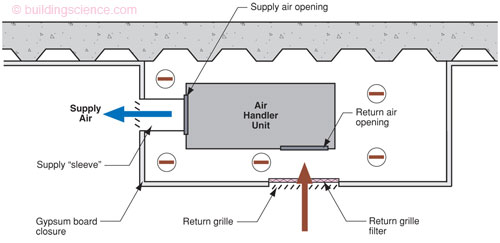
Figure 5: Fan Coil Return Plenum—Filter grille not connected to fan coil unit with a return sleeve leading to increasing negative pressures within dropped ceiling as filter gets progressively dirty.
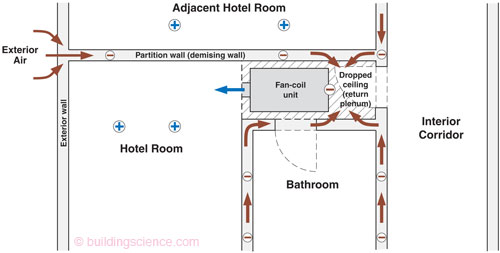
Figure 6: Accidental Flow Paths—Interior walls connecting to dropped ceiling return plenum of fan coil unit become ducts that can connect to neighboring spaces and the exterior.
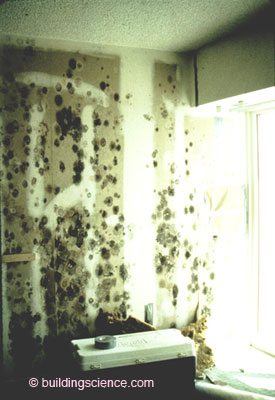
Photograph 6: Demising Wall Mold—Mold on demising wall due to coupling of fan coil unit return plenum to demising wall creating flow path between exterior and interior.
How do we fix this? Add a return sleeve to match the supply sleeve thereby connecting the filter grille directly to the unit. Now add an additional grille to “bleed” the pressure created by leakage in the air handler itself. This grille can be small (4 inches by 8 inches) and can be in the ceiling of the enclosure around the unit (right beside the return filter grille). Don’t install it in the demising wall (remember the exploding heads…). And oh yes, don’t install vinyl wall coverings. Let me also tell you what does not work—extending the exterior gypsum board past the demising wall where it intersects the exterior wall to provide an air barrier. In theory such an air barrier should work—but in practice it does not as we can not get the gypsum board to be sufficiently airtight. The negative pressure field needs to be eliminated as well. Getting rid of the interior to exterior wall connection is a really good idea, but by itself it is not enough.
So where are we now? We have to live with being hollow—we are not going to go back to heavy expensive massive resource intensive unsustainable buildings. We have to learn to “compartmentalize” in order to break up the three dimensional airflow networks. This includes a complete continuous air barrier system on the exterior. We must not accidentally couple HVAC systems to building enclosures and we must equalize pressures between the hollow spaces and the conditioned space. And we should learn to love fully ducted returns and be very wary of return plenums.
References
[1] Lstiburek, J.W.; The Pressure Response of Buildings, Thermal VII – ASHRAE/DOE/BTECC, December 1998.

